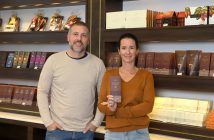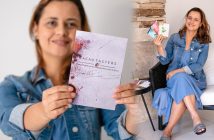How chocolate production in the Yanomami Indigenous Land could be the answer to illegal gold mining.
An old indigenous legend locates the birthplace of humanity in the region of the Uraricoera river. Makunaima, the mythical hero that inspired Mario de Andrade’s celebrated novel, was born by the sounds of its rapids, that descend from the high mountains separating Roraima (in Brazil) and Venezuela. Today the Uraricoera and the other rivers flowing through the lands inhabited by the Yanomami and Ye’kwana Indians are polluted by mercury. Indigenous communities have to resort to artesian wells to obtain drinking water and can catch ever fewer fish.
Until recently, intense movements of boats and aircraft revealed the outbreak of the new explosion of mining, returning to the indigenous territory after having killed about 15 percent of the indigenous population of the region in the late 1980s. The global financial crisis has raised the price of gold, while internal misadministration has depressed the value of the Brazilian currency. All this has fed the appetites of illegal gold prospectors, with the veiled support of the political establishment.

Área próxima às comunidades, na beira do rio Uraricoera, destruídas pelo garimpo ilegal © Rogério Assis/ISA
The indigenous community of Waikás is a few miles from a large gold mine, known as “tatuzão” — the big armadillo — due to the size of the crater opened in the forest by a village of about a thousand people dedicated to separating alluvial gold from the soil in which it is impregnated. The devastation results in deforestation (in this case, about 300,000 m2), in the creation of lakes by pumping water, and of mud that dirties the rivers, all the while using mercury to separate the gold from the soil.

Área próxima às comunidades, na beira do rio Uraricoera, destruídas pelo garimpo ilegal © Rogério Assis/ISA
In July 2018, the official estimate was of around two thousand prospectors illegally installed in the Indigenous Land. Indigenous organizations argue there are five thousand. In August, a joint operation by several federal agencies called Curare IX, under the leadership of army General Gustavo Henrique Dutra de Menezes, established permanent monitoring bases along the main rivers of the Yanomami Indigenous Land to combat the illegal mining. The ostensive presence of soldiers at strategic points disrupts river and even airborne supply lines, stifling mining activity.
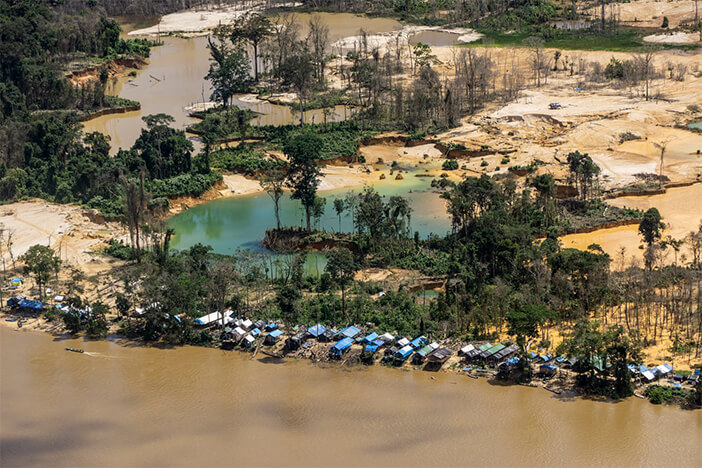
Área próxima às comunidades, na beira do rio Uraricoera, destruídas pelo garimpo ilegal © Rogério Assis/ISA
According to data from the military command in Boa Vista, by 1 November 2018, 1,830 prospectors had left the region, drastically reducing activity, without, however, managing to end it. In overflights during October, I could still observe mining camps. Some tried to stay underneath the tree canopy so as not to be seen from the air.
One of the dramatic aspects of the prospecting invasion is that it attracts indigenous youths in search of cash to acquire the consumer goods that have become current necessities, from clothes to cell phones, and including pots, pans and food. As well as distancing themselves from their traditional culture, by joining in the prospecting these youths end up legitimizing the activities of the invaders.
“Before, we used to barter; when our grandparents needed something, they exchanged. They did not use money. They bartered canoes, arrows, bows, and so on. The elders used to say, don’t touch money otherwise you’re going to go crazy. Later, when we wanted tools, machetes, rasps, tools for making canoes, we could get these by bartering. But now, the young people want other, more expensive things: no one lives without a cell phone, tennis shoes or other white people’s things that need to be bought with money”, says Felipe Gimenes, a Waikás leader.
When thinking about non-destructive alternatives capable of generating additional income for the communities, some Ye’kwana leaders realized that the forest offers another kind of “gold”: the native cocoa pod could constitute an alternative source of income that could prevent young people from being attracted to becoming cheap labour for the prospectors. The cacao fruit is endemic in the area, even being mentioned in Yanomami origin myths.

Dos cacaueiros, alternativa de renda: o cacau, conhecido como “fruto de ouro”, pode evitar que jovens sejam atraídos pelo garimpo ilegal. © Rogério Assis/ISA
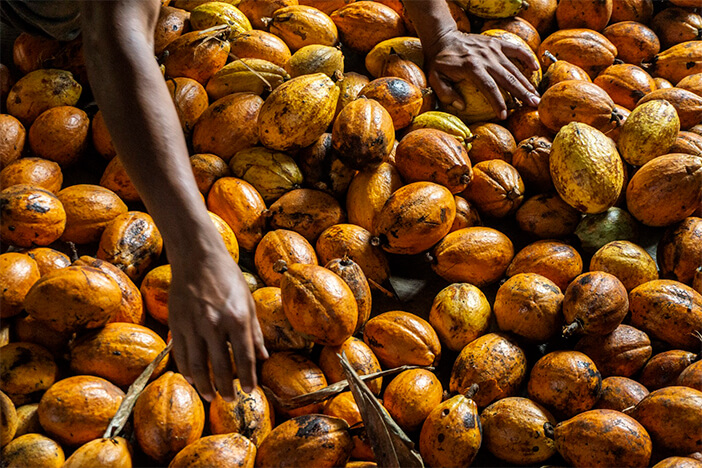
Dos cacaueiros, alternativa de renda: o cacau, conhecido como “fruto de ouro”, pode evitar que jovens sejam atraídos pelo garimpo ilegal. © Rogério Assis/ISA
Also known as the “golden fruit”, cocoa is seen as a possible antidote to the invasion by illegal miners of the Indigenous Land in the extreme north of Brazil. Local community leaders, both Ye’kwana and Yanomami, plan to produce chocolate for the international market as an income alternative, so that indigenous youths have no need to collaborate with illegal miners.
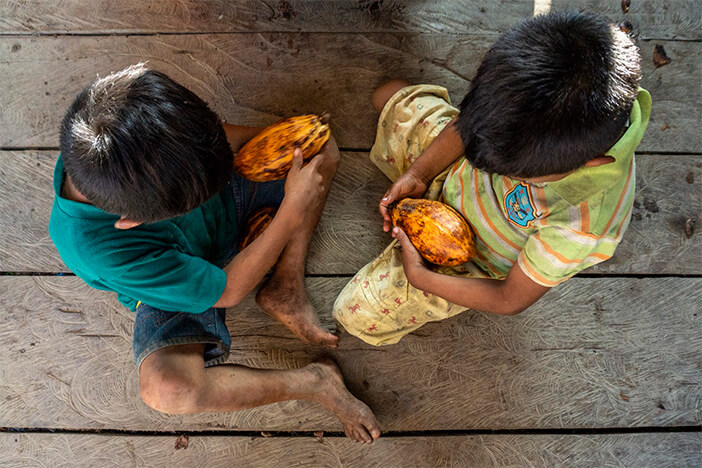
Dos cacaueiros, alternativa de renda: o cacau, conhecido como “fruto de ouro”, pode evitar que jovens sejam atraídos pelo garimpo ilegal. © Rogério Assis/ISA
In July, a workshop organised by the Wanasseduume Ye’kwana Association, with the support of the Instituto Socioambiental (ISA), was held in the village of Waikás to teach members of different indigenous communities the techniques of harvesting and processing cocoa fruit to produce the raw material for fine chocolate.
On this occasion a historic event ocurred: the first chocolate bar in the history of the Yanomami Indigenous Land was produced.
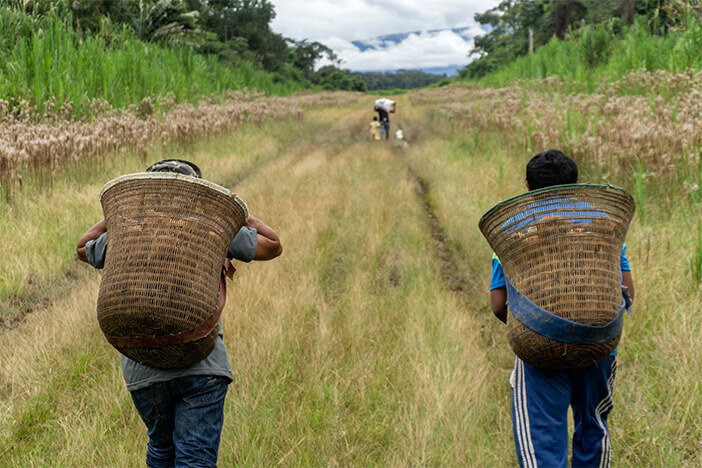
Dos cacaueiros, alternativa de renda: o cacau, conhecido como “fruto de ouro”, pode evitar que jovens sejam atraídos pelo garimpo ilegal. © Rogério Assis/ISA
From cocoa tree to chocolate bar
Traditionally, indigenous people of Roraima use the cocoa fruit in more or less the same way that non-Indians eat a papaya: eating the sweet flesh and discarding the seeds. Local leaders thought about the value of fine chocolate in international markets and decided to include the cocoa fruit native to their forests among the indigenous products sold in large Brazilian urban markets.
The result of this experiment was better than expected: when analysing photos of cocoa fruits sent by Ye’kwana leaders, Roberto Smeraldi, director of the ATA Institute, noted that their shape was unlike any other known variety. An expert in Theobroma cacao (the plant’s scientific name), he sensed that this could be a pure variety, with great potential as a niche product in the market for fine chocolate.
Smeraldi suggested an expedition to Waikás by the chocolatier César de Mendes, a chemist who had studied cocoa and who in 2010 had abandoned his academic career to become a small Amazonian chocolate entrepreneur. His grandfather was a Moroccan Jew who migrated to the Amazon and married. “I am 50% Jewish, 25% Indian and 25% ribeirinho (member of a non-indigenous riverbank community)”, he jokes. As a child he watched his mother preparing cocoa to be consumed in the traditional ribeirinho way, similar to that the first Spaniards encountered when they arrived in Central America in the early 16th century. She would produce a hard bar that was then shaved and mixed with hot water and milk to make an invigorating infusion.

César de Mendes faz a torra das amêndoas de cacau. Para ele, as variedades encontradas do fruto são diferentes das que ele conhece.
Having launched his brand, Mendes travels round the region in search of rare varieties to make single origin chocolates. In 2014, a community on the banks of the Jari river showed him the fruits of their trees and he realized they had unique characteristics. Following laboratory analysis, they were identified as a new variety, which the chocolatier has already exhibited at meetings in various parts of the world.
During the trip to the Yanomami Indigenous Land, coordinated by the ISA anthropologist Moreno Saraiva Martins, César de Mendes noted the occurrence around Waikás of two distinct varieties, one with characteristics that he says are different from anything he had seen before.
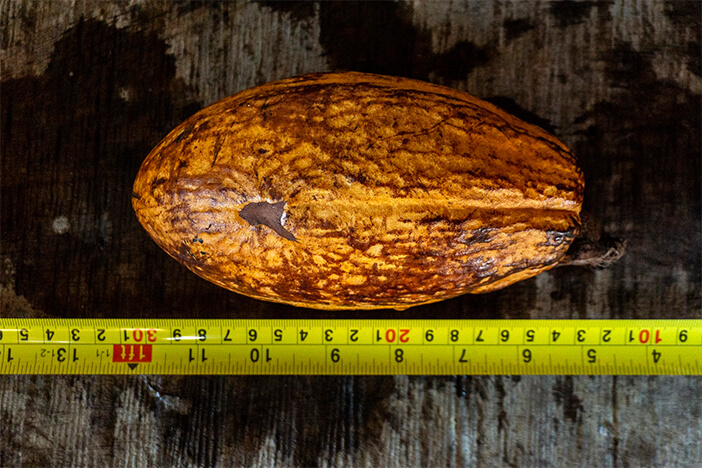
Processo de feitura do chocolate com cacau nativo da Terra Indígena Yanomami, da coleta, passando pela fermentação, até a barra final © Rogério Assis/ISA
As well as analysing the fruits, the chocolatier held workshops with leaders from several Ye’kwana and Yanomami communities to teach them how to process the fruits and their seeds to make fine chocolate. Leaders and members of fourteen indigenous communities in the region took part, a Ye’kwana and thirteen Yanomami, speaking four different languages: the Ye’kwana language belonging to the Karib language family, and three of the five languages of the Yanomami linguistic family. The Ye’kwana and the Yanomami share part of their territory, both in Brazil and in Venezuela.
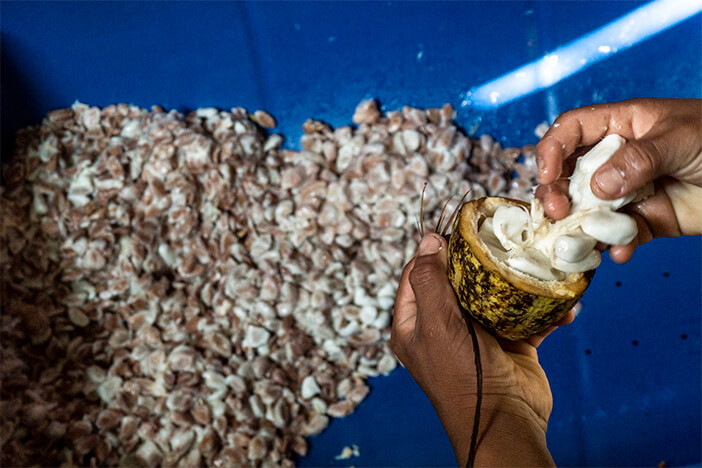
Processo de feitura do chocolate com cacau nativo da Terra Indígena Yanomami, da coleta, passando pela fermentação, até a barra final © Rogério Assis/ISA
As the Indians of the region traditionally consume only the pulp of the fruit, César de Mendes taught them to perform the four necessary steps for chocolate making — when and how to: harvest the fruits; ferment the pulp together with the seeds; dry the seeds; and macerate these once dry to obtain the powder. The whole process took ten days in July, the rainy season in northern Brazil. Changing old habits and learning something new and exciting was something of a great intercommunity celebration for the visitors to Waikás.
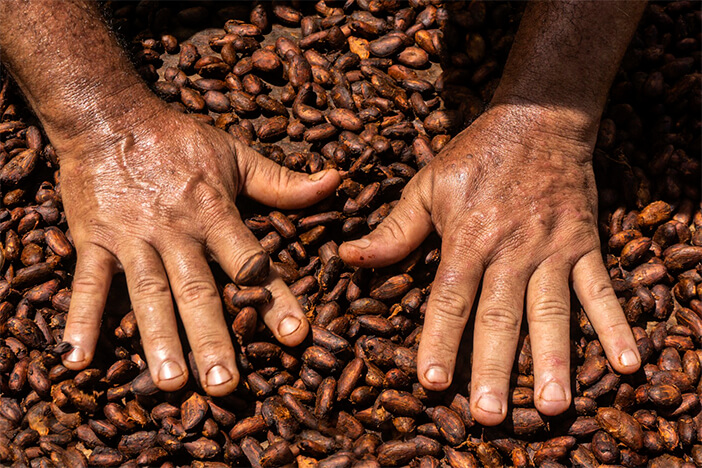
Processo de feitura do chocolate com cacau nativo da Terra Indígena Yanomami, da coleta, passando pela fermentação, até a barra final © Rogério Assis/ISA
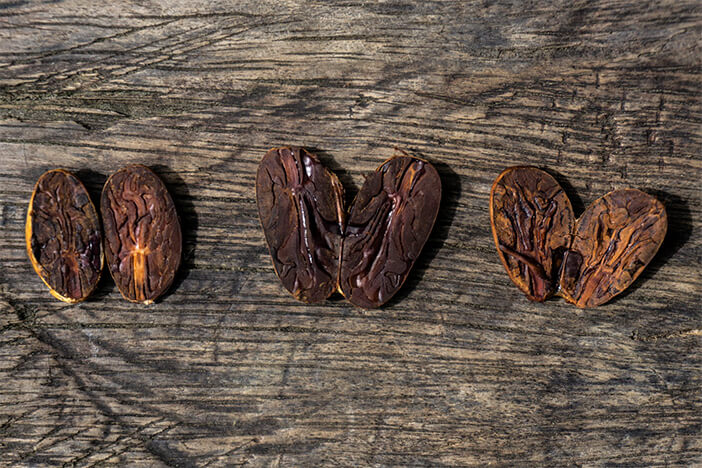
Processo de feitura do chocolate com cacau nativo da Terra Indígena Yanomami, da coleta, passando pela fermentação, até a barra final © Rogério Assis/ISA
Korekorema community leader and director of the Hutukara Yanomami Association, Resende Sanöma was excited by the activities: “We are very happy that Mendes is teaching us how to work with cocoa”. Resende jokes about their relationship with chocolate: “We don’t know how to make chocolate. We are familiar with Nescau [Nestlé chocolate powder] and chocolate biscuits, but not with how chocolate is produced, although it is made from cocoa that grows in our forests”.

Processo de feitura do chocolate com cacau nativo da Terra Indígena Yanomami, da coleta, passando pela fermentação, até a barra final © Rogério Assis/ISA
For the Yanomami of Korekorema, generating additional income is particularly strategic. In 2017, they decided to migrate from higher ground in Auaris, where a heavy concentration of communities led to a reduction in hunting, to the edge of the river Uraricoera, founding a new community. The change has brought benefits, but also threats: “There is more hunting here, but we are also suffering from malaria, because of the prospectors. And we are worried that the river is polluted with mercury. So, we need an artesian well. All this means we need money to buy things that previously we didn’t need. And cocoa, making chocolate, can give us that”, he explains.
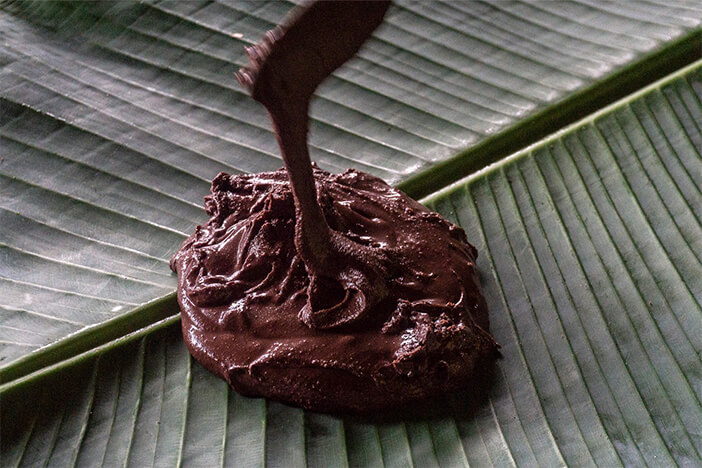
Processo de feitura do chocolate com cacau nativo da Terra Indígena Yanomami, da coleta, passando pela fermentação, até a barra final © Rogério Assis/ISA
After the trip, César de Mendes took the fermented cocoa to Belem to test its quality for chocolate production. The plan agreed with the Indians is that, starting in 2019 with a gradual increase in chocolate production, they will be able start testing the potential of a product in the form of bars. But before leaving, Mendes produced the first chocolate bar in the history of these communities, produced entirely by them, from the harvesting of the fruits to the sample tasting of a 70% chocolate bar, similar to those that enjoy success in urban markets.
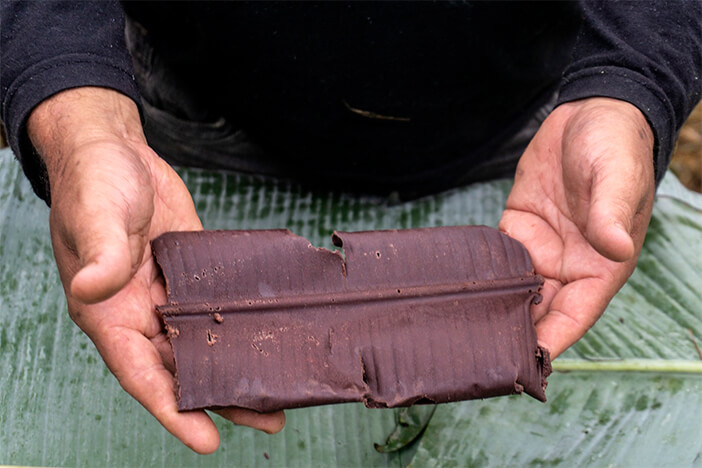
Processo de feitura do chocolate com cacau nativo da Terra Indígena Yanomami, da coleta, passando pela fermentação, até a barra final © Rogério Assis/ISA
The prospectors’ return and the ‘golden fruit’.
When the Mendes expedition arrived at the Waikás landing strip, where only Indians and those with government authorization are allowed, six prospectors, one armed, monitored their arrival. Over the next ten days there was a steady stream of boats going up and down the river, supplying the prospectors. At least one unauthorized aircraft used the same landing strip. Other aircraft, including two helicopters, flew in the direction of the settlements housing most of the illegal miners of the Uraricoera river. The number of prospectors stood at five thousand and was growing exponentially until the army’s operation in August 2018.
At 38, Júlio Davi Magalhães Rodrigues (Júlio Ye’kwana) was a child at the time of the great mining invasion in the late 1980s. He watched with fear the suffering of his community and the speed of the invasion by strangers rapidly destroying the world of his parents and grandparents.
The impact of those years brought his generation an awareness that they needed to master the language and the culture of the brancos (non-Indians) in order to stand up to them on their own terms.
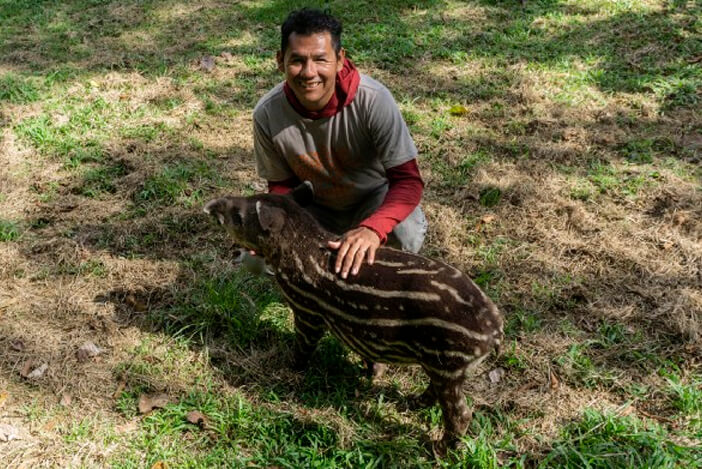
Júlio Ye’kwana: “Precisamos de um dinheiro além de nossas atividades tradicionais. Rendas para as famílias. E o cacau parece ser uma possibilidade.”
This is why several young Ye’kwana have overcome the difficulties of language and culture to go through higher education. Júlio lived in Boa Vista between 2010 and 2015, when he studied indigenous territorial management at the Federal University of Roraima. Another contemporary of his, Osmar, did a master’s degree in Anthropology at the National Museum in Rio de Janeiro, supervised by Carlos Fausto. In addition, there are several members of this ethnic group working as paramedics in Sesai (the official indigenous health service). Since the 1980s, the Ye’kwana have proved to be excellent microscopists in the field of combating malaria. These are Indians holding degrees and using smartphones, far from the stereotype of an isolated people with limited material or technological resources.
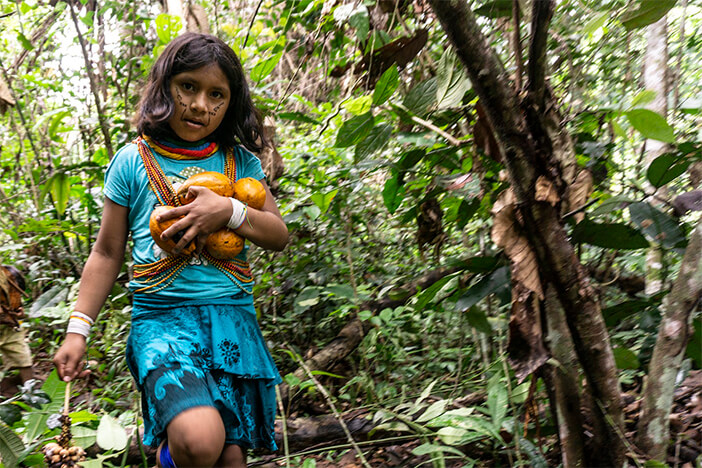
Crianças da comunidade acompanharam a coleta dos frutos e a secagem das amêndoas de cacau fermentadas. © Rogério Assis/ISA
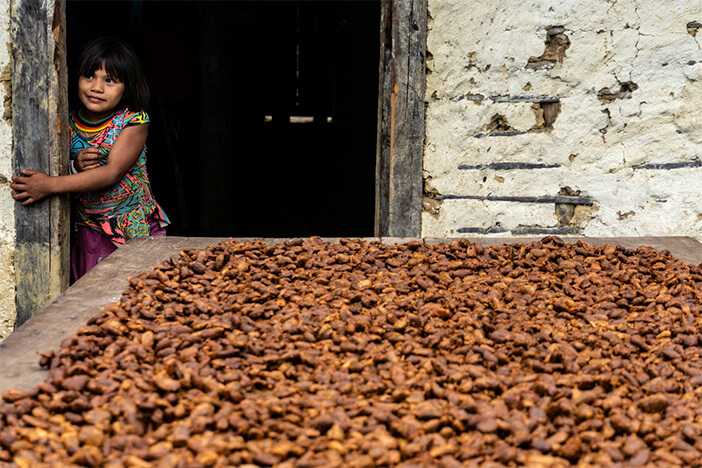
Crianças da comunidade acompanharam a coleta dos frutos e a secagem das amêndoas de cacau fermentadas. © Rogério Assis/IS
During his university course, Júlio joined the Ye’kwana People’s Association in Brazil (APYB). Indigenous peoples create such associations to gain greater exposure and impact for their causes. Today he is its president, forcing him to commute between the community and the state capital.
Julio and the Indians follow everything with a certain caution while, at the same time, being hopeful that the cocoa project will soon be able to face down the temptation of gold. Or, as he says: “The young people were excited by the workshops. They want additional income. Today we can’t live without clothes and other goods that come from the cities. We need money over and above our traditional activities. Income for families. And cocoa seems to be a possibility. This workshop was important. We want to continue. If it works out, we will not have to go to the city to work and earn money. We can earn it right here”.
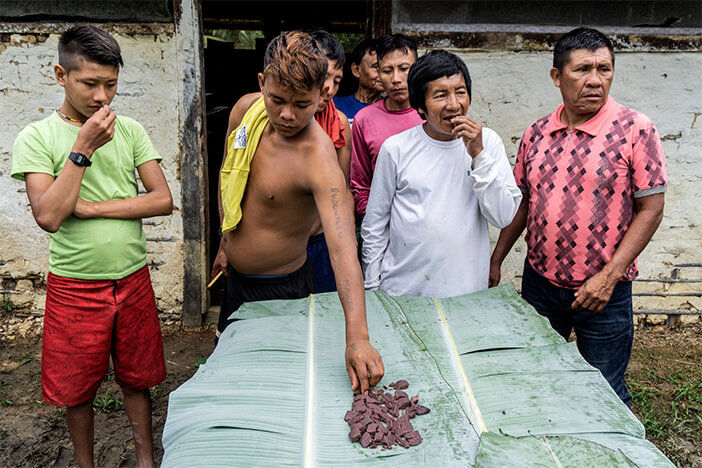
Comunidade experimenta a primeira barra de chocolate produzida na Terra Indígena Yanomami: o fruto nativo pode ser a alternativa de renda para os jovens diante do garimpo ilegal. © Rogério Assis/ISA

Comunidade experimenta a primeira barra de chocolate produzida na Terra Indígena Yanomami: o fruto nativo pode ser a alternativa de renda para os jovens diante do garimpo ilegal. © Rogério Assis/ISA
This report was made possible with the support of the European Union.
By Leão Serva, colaborador do ISA
Photos: Rogério Assis/ISA
Video: Coi Belluzzo
Source: https://medium.com/hist%C3%B3rias-socioambientais/alternativa-cacau-6b8c3f3f8428


